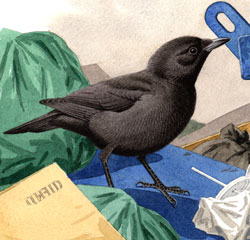Breeding Bird Atlases (BBA)
Find a Bird - BBA1
Breeding Bird Atlas 1 Species Accounts
Fish Crow
Corvus ossifragus
Egg Dates
not available
Number of Broods
one

The Fish Crow is an uncommon and local bird in Massachusetts, where it is near the northernmost part of its range. Stragglers have been observed here for over 100 years, but eventually the species became a permanent resident. It was only as recently as June 1973 that the first breeding record for Massachusetts was confirmed when two nests were found in Stony Brook Reservation in the Hyde Park section of Boston. During the Atlas period, Fish Crows were found nesting in several locations in the Boston metropolitan area, in southern Essex County, and in Plymouth County; and recently breeding has been suspected in Hampden County. Present breeding locations are in approximately the same areas as the historical sightings.
Throughout most of its range, this species favors coastal and brackish habitats, including wooded shorelines, marshes, beaches, and the vicinity of tidal rivers. In Massachusetts, nests have been found at inland locations, and some individuals are known to forage in large mall parking lots as far inland as Framingham (Blodget). The hoarse caa calls of the Fish Crow can best be described as sounding like those of a “crow with a Boston accent.” In early spring, these calls can be a reliable identification clue, but caution must be exercised because female American Crows give similar sounds when begging from their mates (Chamberlain-Auger). Young of both crow species sound alike, making voice identifications unreliable after the fledging season. The slightly smaller size of the Fish Crow is not always a dependable field mark either, especially if the two crow species are not seen together.
Fish Crows arrive on territory by the end of March, and courtship commences in early April, with display flights continuing during the nest-building period. Both members of a pair participate in nest construction. The nest, built of sticks and twigs and lined with finer material, is smaller and less bulky than that of the American Crow. In Massachusetts, nests have been located in White Pine and Pitch Pine (Forster), and nest building has been observed from April 10 to April 19 (BOEM). Solitary nesting has been the rule in Massachusetts, but loose colonies are often reported in more southern parts of the range. There are no specific egg dates available for the Commonwealth, but these would probably correspond to those of the American Crow, which has a similar breeding chronology and fledges its young at the same time (see account on the American Crow). Adults become less vocal during the approximately 18-day incubation period and generally remain so until the young have fledged in another 21 or more days. In Massachusetts, a pair with one fledgling was observed on July 14, and another pair with three young fledglings was seen on July 27 (BOEM).
During the summer the preponderance of records of the Fish Crow comes from Plymouth County; however, in winter almost all reports are confined to a narrow belt along the Sudbury River and particularly the Sudbury landfill. They seldom consort with the American Crows feeding in the surrounding, extensive agricultural fields. It is not known to what extent, if any, the state population is migratory.
Map Legend and Data Summary
Atlas 1 data collected from 1975-1979


Note: uncommon and local in southeastern Massachusetts and Greater Boston; occasionally inland; increasing
Robert H. Stymeist



